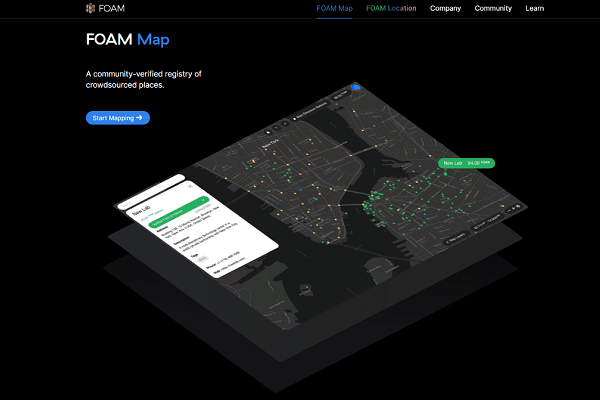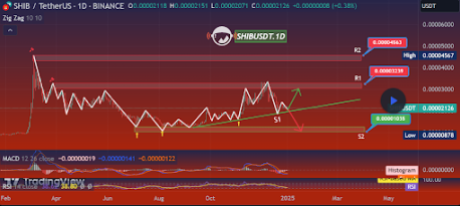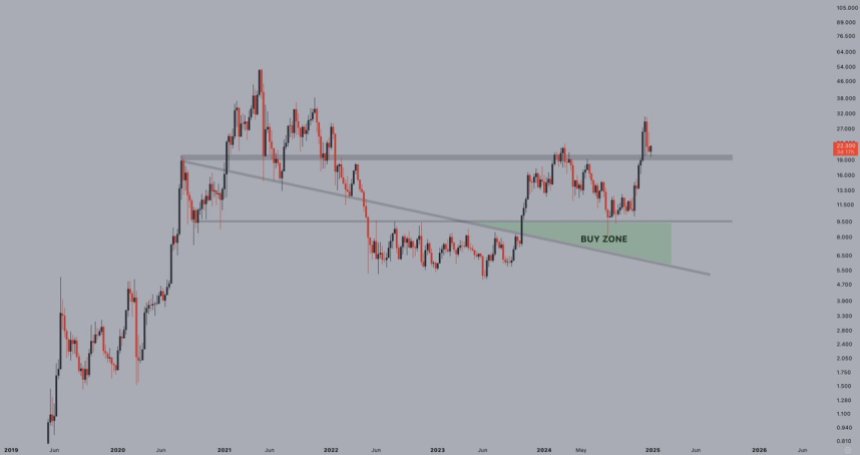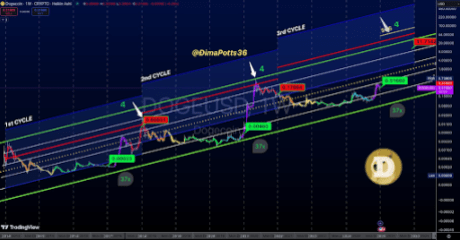- New code fuels rumors X payments launch may be imminent
- What Is AiXBT? The AI Influencer Taking Crypto by Storm
- Polymarket Gives Solana ETF 85% Odds of Approval in 2025
- XRP Price Pattern to Drive a Major Breakout To $3.70?
- ️ Bloomberg discussing Bitcoin 'crashing' below $200 in 2013. Bitcoin is still 'volatile' today at $97,000
- T3 Financial Crime Unit Freezes $126,000,000 in USDT on Tron (TRX) Blockchain in Just Four Months
- Stellar (XLM) Reclaims $13 Billion Market Cap With 16% Rise In 24 Hours
- Congressman Buys More Ski Mask Dog Coin: Will Meme Coin Hit New All-Time-Highs On Latest Disclosure?
- Max Keiser: Why Nations Are Racing for Bitcoin!
- Could PEPE become the next Dogecoin?

Read other parts of this article here,
Part-I of this article: FOAM: Future of digital-maps, Google-map Killer?
Part-III of this article: FOAM: Team, Tokenomics, and Traction
A New Standard: Crypto-Spatial Coordinates (CSCs)
The starting point is something called Crypto-Spatial Coordinates.
CSC is a new shared location standard. To put it simply, it allows any blockchain application to make an immutable claim to a blockchain address and a corresponding location on the map.
With a CSC, any physical location can have a corresponding smart contract address accessible for decentralized applications. This adds a new spatial dimension to the Blockchain Ecosystem.
How Crypto-Spatial Coordinates Work
A CSC consists of location information based on an Ethereum address and an open standard called geohash.
A CSC resolution is excellent — about one square meter (or about 11 square feet). Thanks to this, CSCs can define not only a building but also objects within that building.
CSC is a hierarchical standard, meaning the shorter the CSC address, the larger its area. Longer addresses represent a more specific location, similar to the hierarchical concept of area codes in phone numbers.
You can see examples of CSC addresses in the image below.

The Spatial Index and Visualizer
The Spatial Index and Visualizer (SIV) is like Google Maps for CSC. It’s a visual blockchain explorer and an open-source web app. That means it can be used by any decentralized application that needs to display smart contracts on a map.

For example, a decentralized ride-sharing ecosystem could use the SIV to display the location of available vehicles.
Or think about authorized users of a decentralized supply chain. The SIV could show them the real-time location of their cargo as it makes its way from the supplier to the factory or as a product gets delivered from a warehouse to the consumer.
Geographic Points of Interest and Proof of Location
The FOAM protocol also uses Token Curated Registries (TCRs). TCR is a fancy way of saying a list of something whose quality is ensured by financial incentives.
The way it works is anyone who owns tokens can curate a list. The person making a list needs to stake some of their tokens.
Staking is when you put up collateral in the form of tokens in exchange for a right on the blockchain. This right could be a dividend payout or, in FOAM’s case, the right to add data to the map.
Someone else can add to the list or modify it by also taking some of their tokens. Other users can then vote on approving or denying the changes while taking some of their tokens.
The winning side of the vote gets paid proportionally to their stake with tokens collected from the losing side’s stakes.
In other words, TCRs are a crypto-economic mechanism to generate and maintain high-quality data. TCRs are decentralized without the need to have a supervisor.
CSCs and TCRs are a powerful combination for a new form of mapping and maintaining Points of Interest (POIs).
Points of Interest are one of the most important aspects of a map. They could be stores, cafes, malls, restaurants, museums, or landmarks. When we are driving, it could be real-time data we look for to avoid traffic jams.
With the FOAM protocol, the registries of POIs are crowd-sourced from local markets and communities.
The information is provided and validated by those who contribute to the relevant location. This is a huge improvement over maps created by governments or companies like Google, which are known to sell your data to the highest bidder… often without your permission.
Generally, TCRs are used to create lists such as “best movies in 2018” or “top 10 hotels in New York.”
In the case of the FOAM protocol, TCRs are a great mechanism because the data is objective. The POI, such as a cafe, is either at a certain location or isn’t. POIs are not a matter of opinion.
An entity applying to be on a list is either physically there, or it isn’t. That’s why a POI list curated by FOAM token holders can serve as social proof of location.
A FOAM TCR has three participants:
- Consumers that want to use the list.
- Candidates that want to be on the list.
- Cartographers that curate the list.
Anyone holding FOAM tokens can become a cartographer. The financial incentives behind the staking mechanism ensure high-quality, accurate data.
Growing the FOAM Network
To improve the geographic coverage of the FOAM network, there is a process called signaling.
FOAM token holders can stake tokens about a particular area. These staked tokens work like an indicator that signals the demand for different areas.

An area with many tokens staked on it through the signaling process has higher economic incentives and attracts more cartographers to curate POIs.
Signaling is a grassroots mechanism to bring FOAM network coverage to those areas that show high demand.
Dynamic Proof of Location: A Decentralized GPS Alternative
Dynamic proof of location is the FOAM protocol’s plan to improve upon and replace GPS by offering location tracking for moving objects.
GPS works by calculating differences in time and distance of radio signals.
FOAM is working on adding a time synchronization protocol and hardware radio beacons.
Its dynamic proof of location protocol works similarly to GPS. But it has the added benefit of being decentralized and based on a crypto-economy of FOAM tokens.
Here’s how it works…
The radio beacons are community operated in a distributed network in return for mining rewards. They are like Bitcoin miners… Only instead of trying to solve math puzzles for mining rewards, they provide location data. In exchange, they get paid FOAM tokens.
Anybody can set up a radio beacon and contribute to the network. The radio beacons connect to each other and synchronize their clocks. Then they form zones to provide location services in a given area.
The radio operators are called Anchors. Anchors need to stake FOAM tokens which they forfeit if they don’t follow the FOAM protocol rules.
Verifiers are computers that check zones for fraud. They calculate location algorithms from the time data. Verifiers ensure the network provides accurate data.
Together, Anchors and Verifiers mine location triangulations. They are rewarded in FOAM tokens.
FOAM’s proof of location can provide consensus on whether an event or object is at a certain point in time and space. The protocol issues a fraud-proof, digital certificate called a Presence Claim.
It does this in an open, permissionless, and censorship-resistant way, providing a crucial service to the Blockchain Ecosystem.
Presence Claims also preserve the user’s privacy. They can be kept completely private until the user chooses to share them with an application or another party.
Each zone mapped out on the FOAM protocol works like its own child blockchain.
[A child blockchain, or sidechain, is a separate blockchain attached to a network’s parent blockchain. It increases the network’s transaction capacity by moving some transactions from the parent blockchain to the “side” blockchain.]
Currently, FOAM uses Ethereum as its base blockchain. But FOAM could be connected to any other blockchain.
As far as the radio beacons are concerned, FOAM’s location protocol is hardware agnostic. In other words, it works with different types of hardware.
Real-World Applications for FOAM’s Technology
Currently, FOAM is working on hardware prototypes based on a radio technology called Low Power Wide Area Networks (LPWAN).
LPWAN has the range of a cellular phone. It isn’t super-fast, but its low power requirements translate into long battery life.
Most importantly it operates in an unlicensed radio spectrum. This means there are no licenses or permits required. It is perfectly suited for a secure and decentralized network.
As an example, communities in major cities around the world have emerged that use open-source software and LPWAN to form what’s called The Things Network.
Here is a map of The Things Network in Europe:

Thousands of LPWAN radios already operate all over the world. With FOAM’s protocol, they’ll get paid in cryptocurrency.
In short, FOAM protocol has a well-thought-out technology. It will bring mapping into the 21st century by laying the groundwork for a self-organized, distributed, peer-to-peer network for proof of location.
Providing an economic incentive in the form of a cryptocurrency allows the infrastructure to grow from the bottom up, without the need for central planning.
Areas with the highest demand for location-based services will automatically attract the most zone anchors and cartographers that curate POIs. The free market at its best.
Source: Original




